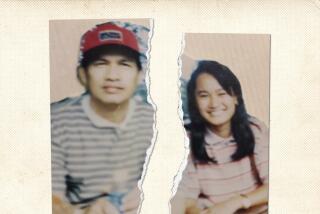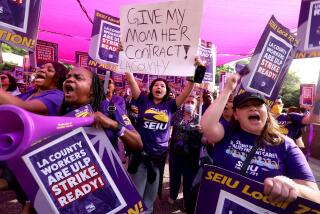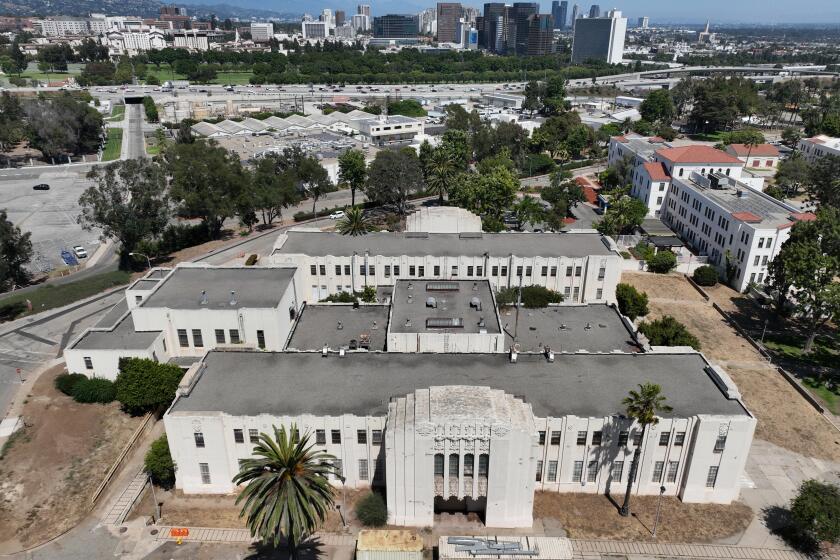Baldwin Hills on ‘Day After’: Grim Contrasts
Ken Bryant stood on the ashes of what had been 4289 Don Carlos Drive, his mother’s home in Baldwin Hills.
“I lost my car, everything in the house,” he said, “But I’m not worried about that. What I’m worried about is her.”
Marian Mouton, his mother, had survived the fire, the 22-year-old bank clerk knew, but he hadn’t seen her and he didn’t know where she was, how she was, or even where she had spent the first night after the dreadful fire that took all but one house on their street.
The “morning-after” scene--firefighters shoveling debris, homeowners picking through rubble, politicians walking through, media cameramen recording--moved around Bryant, who just stood there, as if he wasn’t sure what to do next.
A Leap, a Shout, a Hug
Suddenly he leaped with a shout as a small figure walked toward him on the street. It was his mother.
“I’m all right,” Marian Mouton, 46, said over and over while her son hugged her as if he would never let go.
Wednesday in Baldwin Hills was filled with grim contrasts, of tears and joy, of calmness and anxiety, relief and pain.
Raymond Spicer, his house intact thanks to a fire-resistant composition roof, watered his lawn on Don Jose Drive, right next to several houses that had burned.
Celestine Dean of West Covina accompanied her father, James L. Bennett, back to his home at 4263 Don Carlos. She was able to recognize which ruin was the house where she grew up only by a distinctive gate that still stood across the street, although the home to which it belonged was gone.
Bryant, Dean and Spicer had their loved ones, but the relatives of Marie Gladden were not so lucky.
August Burns, Marie’s bother, drove up and down Don Felipe Drive, with signs on the sides and back of his black Toyota pickup, reading: “Has anyone seen Marie Gladden?”
Gladden lived at 4226 Don Carlos, a newly redecorated and recarpeted blue and white house that was flattened Wednesday. Gladden’s car, a Buick, had melted beside it.
“2:30 p.m. yesterday was the last we’ve heard,” Burns said. The last person who spoke to her was his wife, Mary, who said Gladden told her by phone she couldn’t leave because she wanted to contact others and warn them of the fire.
Gladden is the widow of a Los Angeles firefighter who lost his life in a Pacific Palisades fire, Burns said. Her son, Robert, is a firefighter and was one of those who fought Tuesday’s inferno.
Her purse had been found at the edge of the property, Burns said, adding, “We’ve been everywhere--to the Red Cross, all the hospitals, even to the morgue.”
Robert Gladden was in uniform Wednesday, as firefighters moved large twisted pieces of metal, stone and charred wood and then shoveled the rest, looking for bodies.
Gladden, who also had grown up on the street, would stop what he was doing occasionally, to show reporters his mother’s picture. But by late in the day, she was still missing.
The death toll stood at two until shortly after 8 p.m., when authorities reported that they had found a human body in a bathtub in the home next door to the Gladden residence. The remains were those of a woman, but no further details were released.
The streets affected by the fire are part of a winding section of Baldwin Hills locally referred to as “the Street of Dons” because they all begin with the word “Don.”
The hills, originally owned by the colorful 19th-Century land speculator “Lucky” Baldwin, were first developed after World War II. Middle-class blacks began moving there in the late 1950s, and now it is often called “the black Beverly Hills,” with home values estimated at $250,000 and above.
The Street of Dons area is a close-knit community, mostly because people have lived there more than 15 or 20 years.
“I saw these people’s children grow up,” Charles Palmer of 4577 Don Milagro Drive said helplessly of his neighbors on either side and across the street. Their houses, all of which had wood shingle roofs, were destroyed, while his, with a rock composition roof, was spared. He and his wife were alone on the street Wednesday and they felt worse, they said, because the victims were friends.
Dorothy Lindsey walked down Don Carlos with her niece, who carried an ax. Her nephew carried a rake and her brother-in-law plastic bags and heavy gloves. She stopped at 4227.
It was the first time she had seen her home since before the fire. Two chimneys remained, along with a blackened pine tree that still framed a beautiful view of the hills across La Brea Ave.
“This is the first time I’ve seen this,” she said, her voice catching. “A neighbor called me at work (at the Department of Water and Power) and said, ‘Your house is on fire.’ But I couldn’t get back in, because of the smoke and the heat.”
Her nephew, Dennis Brown, found a half-charred piece of paper, then a broken jug and a bowl, and set them them aside carefully, as if he were dealing with treasure. Her niece, Denise Brown, found what appeared to be some pieces of jewelry, and picked them out of the ashes meticulously, to protect her manicure.
Television crews gathered around, and Lindsey numbly repeated her story, sometimes breaking into tears. Then firefighter Robert Gladden came over to hug her, and she gratefully clung to him for several minutes.
Up the street, 80-year-old Mary Ward stood in front of her home at 4243 Don Carlos, which was also in ruins.
“The worst thing was my two little dogs, Kisha and Teddy,” she said, referring to her poodle and “cockapoo.” She had been unable to return home in time Tuesday to save them.
“When I got here the whole house was gone,” she added, sadly. “I guess they’re in there somewhere.”
Deeann Thomas, 45, also “lost everything,” she said of her home at 4286 Don Carlos. “Nothing is left.”
But she was already thinking of the future.
“We’ll rebuild,” she said. “It was a beautiful place to live. I want to live here. It’s my home.”
More to Read
Sign up for Essential California
The most important California stories and recommendations in your inbox every morning.
You may occasionally receive promotional content from the Los Angeles Times.










